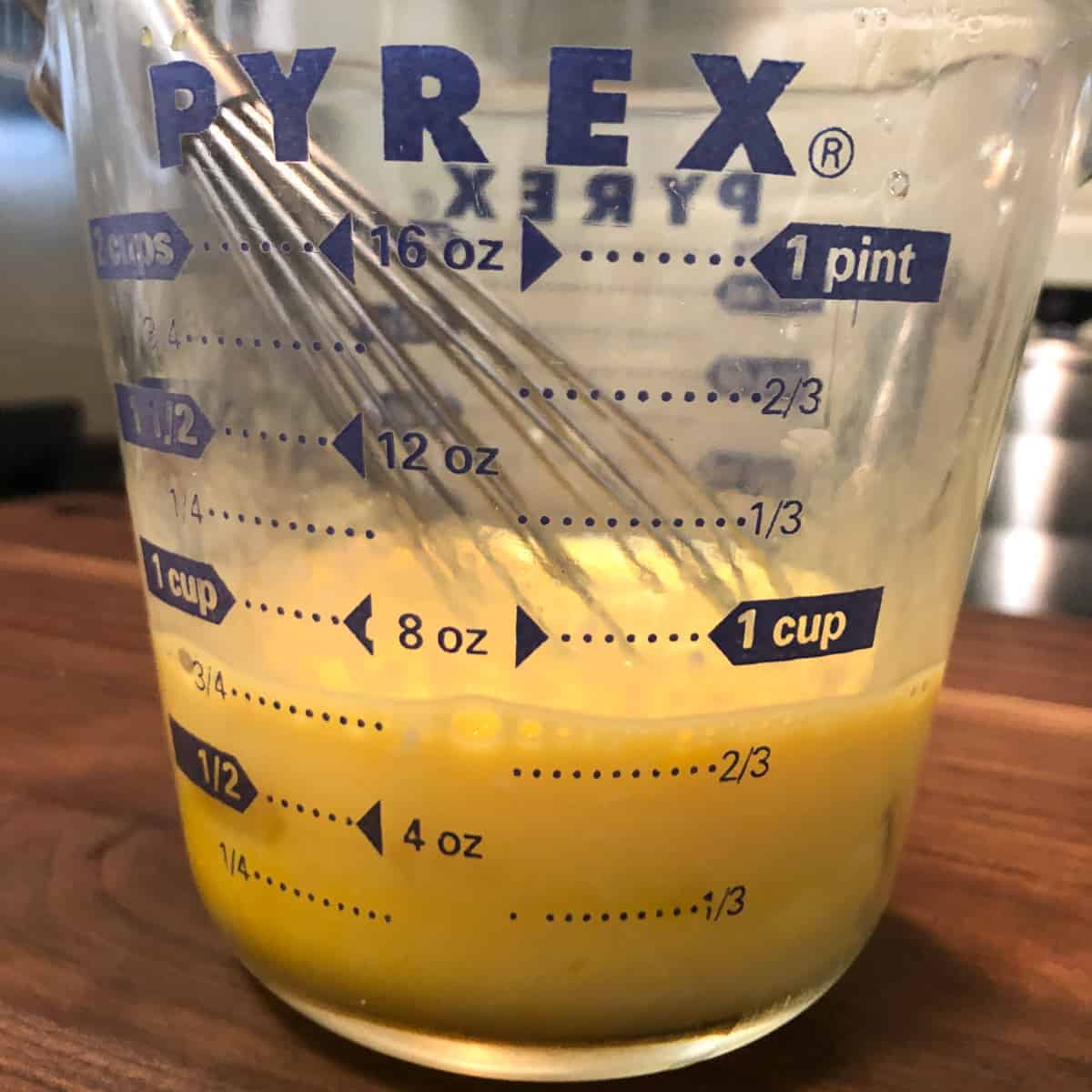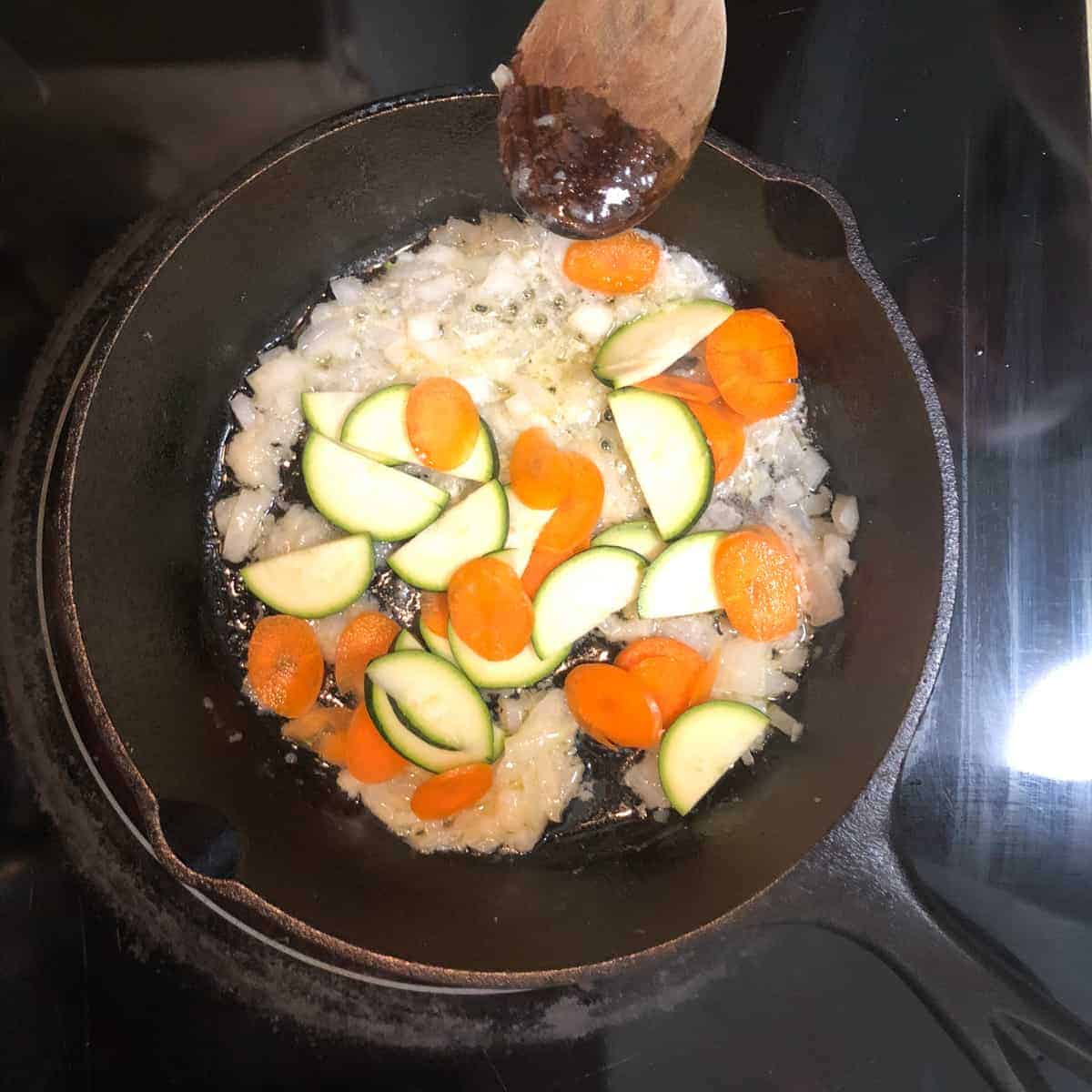This single-serving Frittata recipe is easy and oh-so customizable. Use your favorite veggies, add cheese, and create your own signature perfect Frittata. My favorite cheeses to cook with eggs is, without a doubt, Gruyere or a nice Brie. So delicious!
Have some leftover veggies, try this tomato quiche for one or an individual olive and cheese quiche or these easy mini spinach quiche.

- A Frittata made with fresh vegetables is quick, easy, and simple to cook any night of the week.
- It’s a great way to use leftover veggies and potatoes from the previous night’s dinner.
- You can make a Frittata as hearty or light as you like. Add fresh spinach and cherry tomatoes.
- Similar to crustless quiche.
Frittata Cooking Tips
- Before adding the eggs to ingredients like sauteed spinach first squeeze out the excess moisture.
- Spread your veggies evenly throughout the pan before pouring in the eggs. At most you want to give the pan a little shake to even out the vegetable and egg mixture so it cooks evenly.
- A small 5.5-inch cast-iron skillet is perfect for making a small frittata for one; the skillet can go straight from stovetop to oven. Cast iron skillet retains heat, so be very careful when transferring it to and from the oven. I recommend a silicone handle for your cast iron skillet, make sure it fits properly so it doesn’t slip off. Cast iron skillets are heavy; use the smallest skillet required for the recipe. This Frittata recipe is scaled for one serving and made in a small 6.5-inch Lodge skillet. Cut the recipe in half for an even smaller serving and cook in the smaller 4-inch cast iron skillets.
- No cast iron skillet, no problem, you use a 12-ounce baking ramekin!
- You can eliminate the butter and increase the olive oil with good results.
Some Great Flavor Combinations
- Broccoli, Spinach, and Garlic
- Artichoke and Spinach
- Classic Mushroom and Tomato
- Red Peppers, Red Onions, Zucchini, and top with fresh Avocado
- Olive and Gruyere Cheese. (check out my olive quiche recipe)
How to know when the eggs are fully cooked?
For safety, eggs should be cooked to an internal temperature of 160 degrees Fahrenheit. The simplest way to check is to use an instant-read thermometer. I love my Thermopop instant Read Thermometer.
What to do with leftover Frittata?
After the Frittata has cooled to room temperature, cover and refrigerate for up to 24 hours to retain the best flavor and texture.
When I have leftovers, I have a Frittata sandwich the next day. Slice open a fresh crusty croissant and spread just a hint of jam on the inside, then place a slice of the leftover Frittata in the middle. The best easy breakfast sandwich, ever!
Step by Step Instructions
The recipe card also includes a slide show video of the instructions.

In a medium bowl or measuring cup whisk the eggs and the sour cream until mixed well.

Heat a cast iron skillet over medium-high heat Melt the butter in the skillet and saute the onions and garlic until tender and fragrant, about 2 minutes.

Add the carrots and zucchini and saute for another 3-4 minutes until the vegetables are tender, stirring occasionally.

Add the red pepper slices and broccoli florets and continue to cook for another 3-4 minutes.

Pour the eggs into the skillet and give the mixture a light stir or shake the pan just enough to mix the ingredients. Season with salt and red pepper flakes.

Cover the skillet and cook for 6-7 minutes or until set. Transfer the skillet to under the broiler and broil for 1-2 minutes, just enough to lightly brown the top of the Frittata.

Remove from under the broiler and let sit for a few minutes before serving.
- If you are a fan of Frittata’s you might enjoy my gruyere and olive quiche.
- I never invert or flip my frittata; instead, I cover the pan and cook until set, then lightly brown it under the broiler.
- This vegetable frittata is my go-to recipe for a quiche light summer meal.
The difference between a quiche and a frittata
The three main differences are crust, egg to dairy ratio, and the cooking method.
Serving Suggestions?
- Salad: a simple green salad with a lemon vinaigrette is a classic side dish served with quiche.
- Soup: Tomato soup compliments quiche especially when served as an afternoon or evening meal.
- Fresh bread: go minimalist and serve a hunk of fresh bread with butter.
- Fruit bowl: go healthy and serve fresh in-season fruit.
- Potatoes: I like roasted red potatoes with garlic glaze,or for an old-fashioned flair go with fried potatoes.
Want to Save This Recipe?
Enter your email & I’ll send it to your inbox. Plus, get great new recipes from me every week!
By submitting this form, you consent to receive emails from A Weekend Cook®.

Cast Iron Skillet Vegetable Frittata
Ingredients
Recipe Directions
- In a medium bowl or measuring cup whisk the eggs and the sour cream until mixed well.
- Heat a cast iron skillet over medium high heat .Melt the butter in the skillet and saute the onions and garlic until tender and fragrant about 2 minutes.
- Add the carrots and zucchini and saute for another 3-4 minutes until the vegetables are tender, Stir occasionally.
- Add the red pepper slices and broccoli florets and continue to cook for another 3-4 minutes.
- Pour the eggs into the skillet and give the mixture a light stir or shake the pan just enough to mix the ingredients.
- Season with salt and red pepper flakes. Cover the skillet and cook for 6-7 minutes or until set.
- Transfer the skillet to under the broiler and broil for 1-2 minutes, just enough to lightly brown the top of the Frittata.
- Remove from under the broiler and let sit for a couple minutes before serving.
Nutrition
Notes
-
- Before adding the eggs to ingredients like sauteed spinach first squeeze out the excess moisture.
-
- Spread your veggies evenly throughout the pan before pouring in the eggs. At most you want o give the pan a little shake to even out the vegetable and egg mixture so it cooks evenly.
-
- No cast iron skillet, no problem, you use a dutch oven or even a baking dish!
- Cook the vegetables before adding them to the eggs.
- For the creamiest frittata, use full-fat dairy. You can use milk, cream, or a dollop of sour cream or yogurt. The fat adds richness and helps the frittata set properly.
- Whisk the eggs thoroughly with the dairy until the mixture is light and frothy. This incorporates air and makes for a lighter, more tender frittata.
- Before adding your eggs, preheat your cast-iron skillet with a bit of butter or oil. This will help create a non-stick surface and give your frittata a nice, golden crust.
- Cook the frittata on the stovetop until the edges start to set, then transfer to the oven to finish cooking. This method gives you a frittata that’s creamy on the inside and crispy on the outside.
- Remember, the frittata will continue to cook a bit after you take it out of the oven due to the residual heat in the cast-iron skillet. To avoid a dry frittata, take it out of the oven when the middle is still slightly wobbly.
- Let your frittata rest for a few minutes after you take it out of the oven. This will make it easier to slice and serve.
